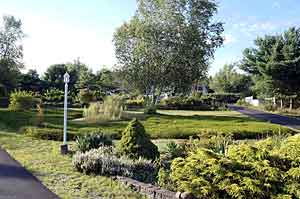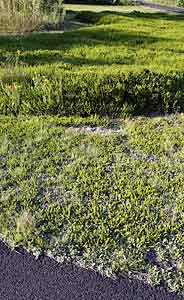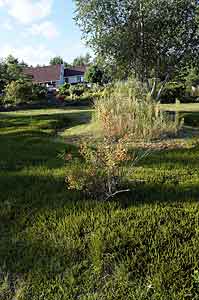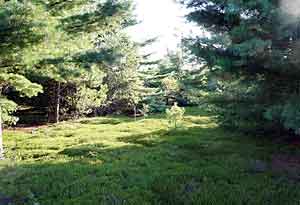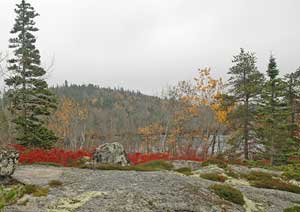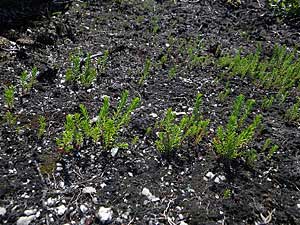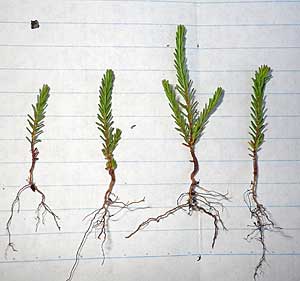Ericaceae: Corema conradii (Torr.) Torr. ex Loud.
(broom crowberry)
Corema conradii is one of three crowberries in Nova Scotia; others are Empetrum nigrum (black crowberry) and Empetrum eamesii (rockberry).1 They are low evergreen shrubs with small, needle-like ericoid leaves and reduced, wind-pollinated flowers. C. conradii has an erect, candleabra- or broom-like growth form, reaching 15-50 cm height. C. conradii is dioecious with terminal flowers appearing in late April/May.
The species is abundant in open pine barrens in Nova Scotia (often associated with bearberry) and on somewhat exposed rock ledges and gravelly areas near the coasts. It is not recorded for Cape Breton. Martine et al.2 comment that “ throughout its range, C. conradii primarily occurs in habitats historically prone to fire”.
C. conradii is a member of the Atlantic Coastal Plain Flora. It occurs in small disjunct populations on the Atlantic coast from Nova Scotia to New Jersey. Reports of C. conradii occurring in Newfoundland are apparently erroneous.3 Populations in Nova Scotia are cited as secure (S4). In contrast, it was either never present or is extirpated in New Brunswick4, imperilled (S2) in the Magdallen Islands of Quebec and in P.E.I. , has S3S4 status in Maine and S1 (at risk) to S3 (sensitive) status for other U.S. states where it occurs (Massachusetts, New Jersey, New York). However, threats to C. conradii habitats cited by the Center for Plant Conservation in the U.S. apply also to Nova Scotian habitats. These include shoreline erosion, deer browsing, trampling, fire suppression, development.5 and invasion by Scot's Pine.6 The Annapolis heathlands, dominated by C. conradii, have been reduced to less than 3% of their pre-colonial area (approx. 200 km2).7
Sources | Notes & Refs | Selected Web Resources | Line Drawing
Click on images for larger versions.
|
February 11, 2007. Halifax Co., upland barrens near West Dover. Photographer: JackPine. |
|

|
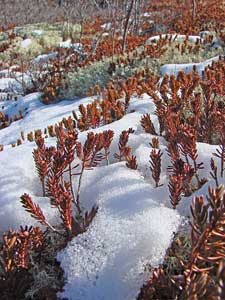
|
|
March 25, 2006. Halifax County: Purcells Cove area, upland barrens. Photographer: JackPine. |
|
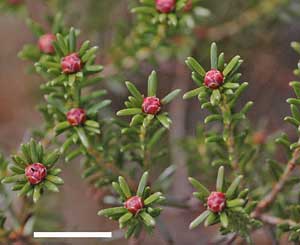 Flower buds. Bar is 1 cm. |
|
|
April 23, 2006. Halifax County: Purcells Cove area, upland barrens. Photographer: JackPine. |
|
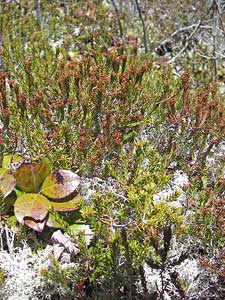 Female (foreground) and |
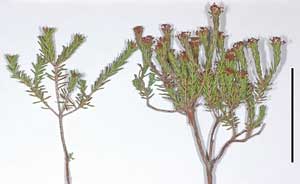 Female (left) and male plants. Bar is 5 cm. |
|
April 30, 2009. Halifax County: Bluff Wilderness Hiking Trail (near Hubley) Photographer: JackPine. |
|
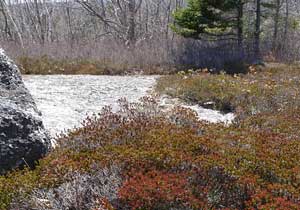 Habit and habitat: thick busy colonies, lichens largely excluded. |
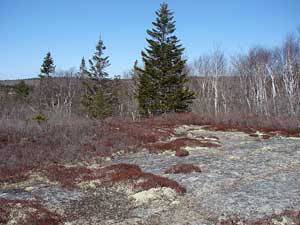 Habitat (March 21): patches of broom croberry and reindeer lichen on the more exposed areas. |
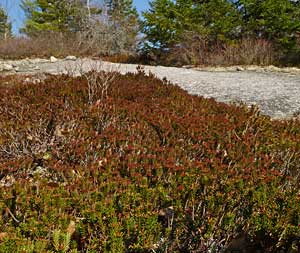 |
At left: Female plants in foreground, male plants behind. Fielding describes males as presenting "a haze of wine-coloured anthers".8 |
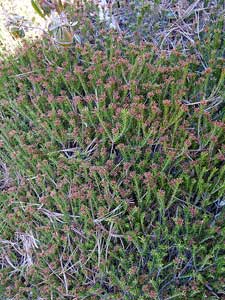 Male plants |
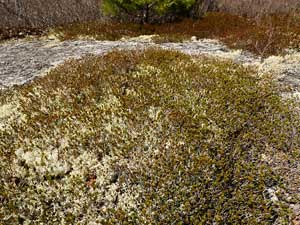 Patch of female plants; male plants in background. |
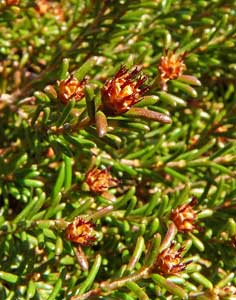 Close-up of female flower. |
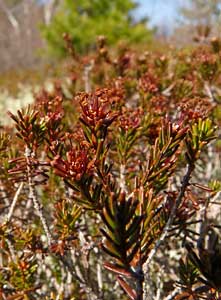 Close-up of male flower. |
|
May 4, 2008. Halifax County: Captain Arnell lands (off of Purcells Cove road). Photographer: JackPine. Notes |
|
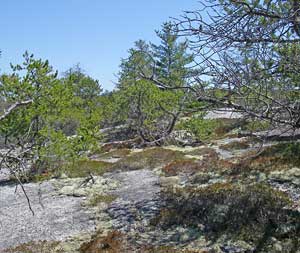 Habitat: jack pine barrens |
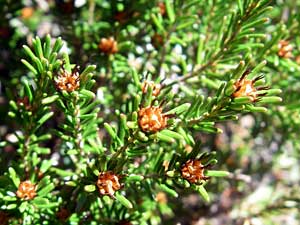 Female flowers |
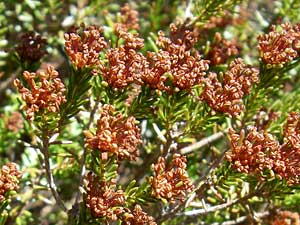 Male flowers. | 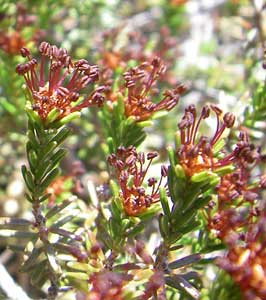 |
|
May 5, 2013. Halifax County: Captain Arnell lands (off of Purcells Cove road). Photographer: JackPine. Notes |
|
 These photos well illustrate "a haze of wine-coloured anthers".8 |

|
|
June 7, 2009. Halifax County: The Bluff Wilderness Hiking Trail, Pot Lake Loop. Photographer: JackPine. |
|
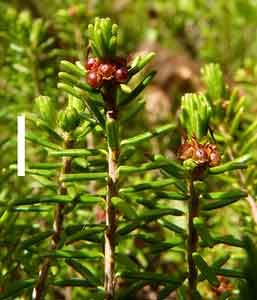 Fruits. Scale is 5 mm, |
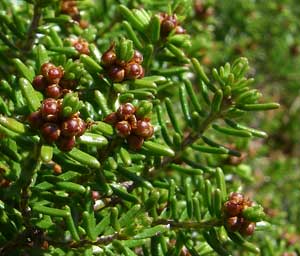 |
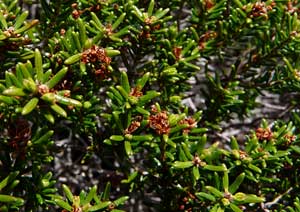 Male flowers (spent), |
|
July 11 & 14, 2009. Halifax County barrens. Photographer: JackPine. |
|
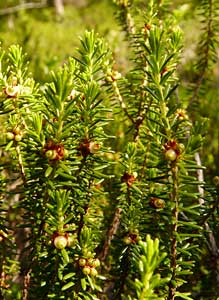 |
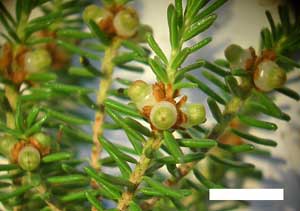
Above and left: Plants on granite outcrop above Oceanview Drive, Halifax manland south, July 11. Bar is 5 mm. Below, plants on barrens of the Bluff Wilderness Hiking Trail., July 14. At both locales, elaisomes9 were observed on fruits (as shown in the photos) and fruits were fully mature, dropping off when plants were disturbed slightly. |
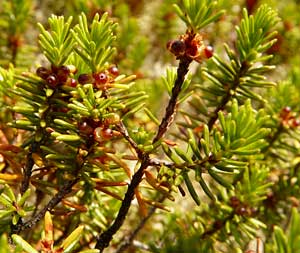 |
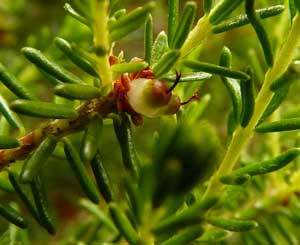 |
|
Aug 3-4, 2008. Shelburne County: Indian Fields pine barrens. Photographer: JackPine. Notes |
|
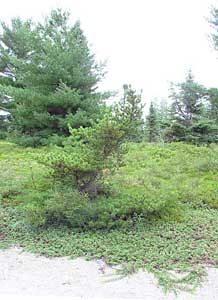 Habitat: sand barrens |
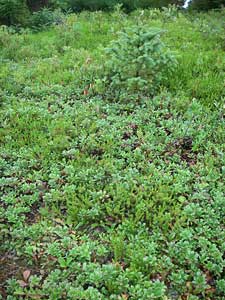 |
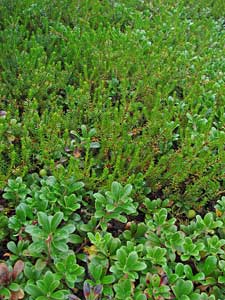
Junction with bearberry (Arctostaphylos uva-ursi). |
 With sweetfern (Comptonia peregrina). |
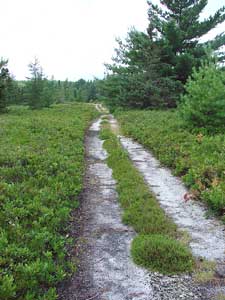 |
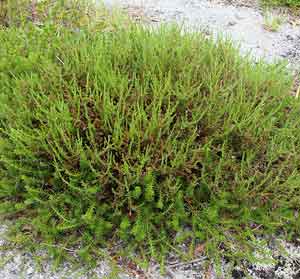
C. conradii growing with Hudsonia ercoides between ATV wheel tracks. |
|
Aug. 16, 2013. Kings County: Kingston Photographer: JackPine. |
|
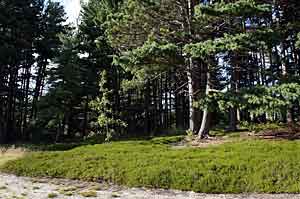 Corema conradii on remnant Annapolis heathland in the Kingston area. It grows in pure stands on thicker sand as above; in thin sand, it was mixed with bearberry (Arctostaphylos uva-ursi) and reindeer lichen as at right, & lowbush blueberry (Vaccinium angustifolia); large patches of Hudsonia ericoides were also seen at this site. |
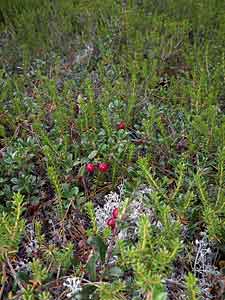
|
 Panorama illustrates the interface between Annapolis pine barrens/heathland and residential development. A ball field lies in the background at left. |
|
|
Aug. 18, 2005. Halifax County: Polly's Cove Photographer: JackPine. |
|
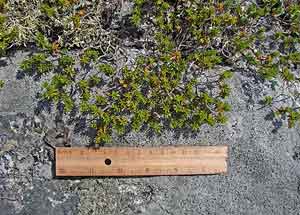 Granite barrens, Corema conradii.. |
 E. nigrum on the same outcrop, in slight depression. |
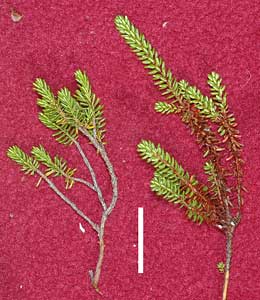 Corema conradii |
Distinguishing C. conradii from E. nigrum can sometimes be challenging when there are no reproductive structures present, especially on drier sites such as this one where E. nigrum takes on a more branched, ascending growth form similar to that of C. conradii. See Three Crowberries for further comments. |
|
Sep. 16, 2006. Halifax County: Polly's Cove Photographer: JackPine. |
|
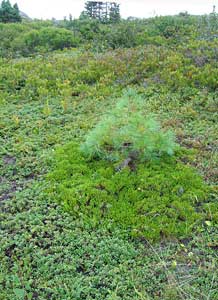 |
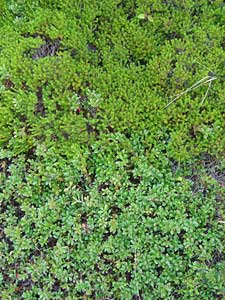
|
Habitat: granite barrens. C. conradii forms a patch around a small white pine; bearberry (Arctostaphylos uva-ursi) in the foreground, Junper commune and huckleberry (Gaylussacia baccata) in background. | |
|
Dec. 2, 2008. Halifax County: Herring Cove Road, close to York Redoubt.
Photographer: JackPine. |
|
 |
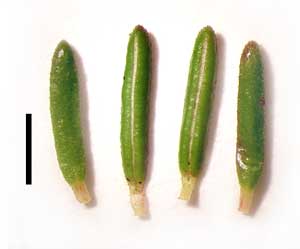 Left: Twigs. Bar is 5 mm. |
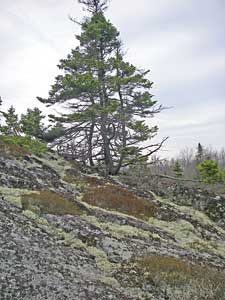 Habitat: Large granite outcrops & erratics . |
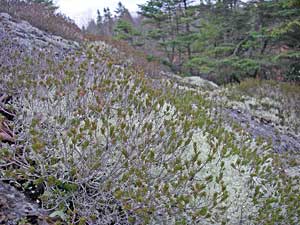 With reindeer lichen . |
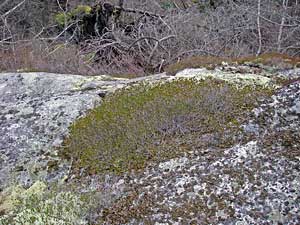 No lichens. |
 Mat pulled back. |
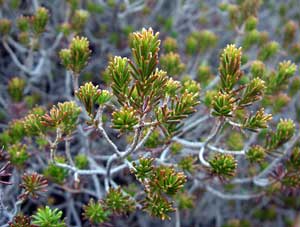 No flower buds. |
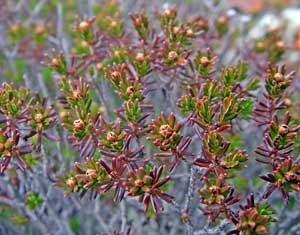 Many flower buds. |
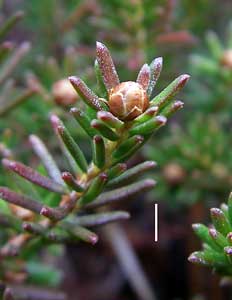
Bar is 2 mm. |
Post-fire photos
|
May 4, 2009. Halifax County: Herring Cove backlands (Purcells Cove Road). Photographer: JackPine. |
|
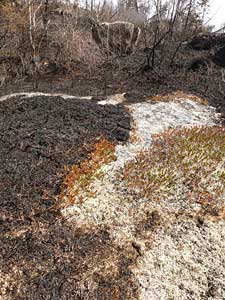 |
C. conradii: a fire prone/fire adapted species. On April 30, 2009, a restricted but severe forest fire on the south mainland region of Halifax burned over barrens that supported large populations of Corema conradii. These photos were taken a few days later. As noted in the introduction, fire supression is a factor reducing populations of C. conradi i. Martine et al.2 reported that “a hot fire burned through one of the most extensive New Jersey populations of this state-endangered species during the summer of 2001, resulting in mortality of nearly all plants in the burned areas. Significant seedling recruitment occurred in the fall of 2002, followed by an even greater seedling emergence the following year.” It appears that established plants were likewise completely destroyed in burned areas of the May 4 Halifax fire. This area has many mature jack pines, an indicator of a fire-dependent plant community. A local resident said that a fire went through the area when he was 5 years old, 44 years ago. |
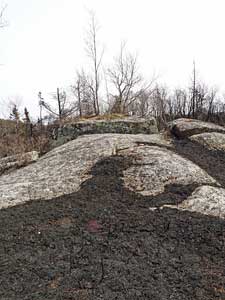 |
 Left photo: in foreground, burned patch of huckleberry and C. conradii; in the background, C. conradii and lichens on top of a large erratic escaped obvious damage (closer view above). |
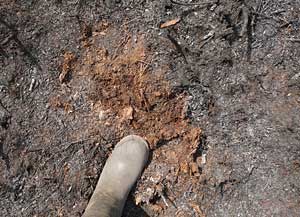 | There was only superficial burning of the peaty soil, thus the buried seedbank may be largely intact. |
|
Aug. 27, 2010. Halifax County: Herring Cove backlands, between Lower Mud Pond & East Pine Island Pond Photographer: JackPine. |
|
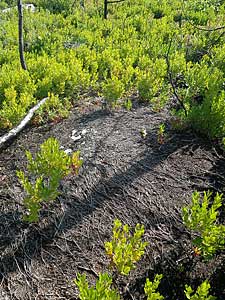 |
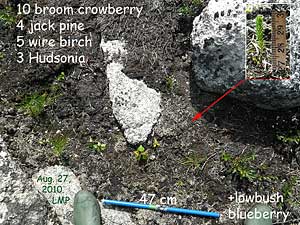 Left: exposed rhizomes of C. conradii. Above: a patch with seedlings of C. conradii. Seedlings were not observed on a visit to this area on July 31, 2010. First appearance of seedlings in the late summer of the year after that of the fire is consistent with observations in New Jersey by Martine et al.2 |
- Taxonomic Status (ITIS) Copy the species name above and paste it into a form on this ITIS Canada page to confirm the nomenclature and list synonyms.
- NatureServe Explorer Copy the species name above and paste it into a form on this page to view a map of its distribution within North America and its conservation status by province and state.
- CPC National Collection Plant Profile: Corema conradii
- Nova Scotia's Dry Bogs This page on the Clean Annapolis River Project website describes the origin of the Annapolis Valley "Dry Bogs" (sand barrens, pine moorlands), their vegetation and related conservation issues. Corema conradii is an important species in this threatened habitat.
Notes & References
- A recent revison of the Ericaceae places the crowberries, formerly inlcuded in the family Empetraceae, in the family Ericaeae. subfamily Ericoideae, tribe Empetrea. See Kron, K.A. et al. 1992. Phylogenetic classification of Ericaceae: molecular and morphological evidence. The Botanical Review 68(3): 335-423.
- Martine, C.T., Lubertazzi,D. & Dubrul, A. 2005. The biology of Corema conradii: natural history, reproduction, and observations of a post-fire seedling recruitment. Northeastern Naturalist 12(3):267-286.
- Maunder, J. and others. A Digital Natural History of Newfoundland and Labrador (www.digitalnaturalhistory.com/) Appendix 1: Species Excluded from the Provincial Flora. Posted at http://digitalnaturalhistory.com/Appendix_1_nfinal.rtf
- Hinds, H.R. 2000. Flora of New Brunswick, 2nd ed. Biology Department, University of New Brunswick.
- CPC National Collection Plant Profile (online): Corema conradii Accessed 25 Nov. 2008 at http://www.centerforplantconservation.org/
- Catling, P. M., and S. Carbyn. 2004. Invasive Scots Pine (Pinus sylvestris) replacing Corema heathland in the Annapolis valley. Canadian Field-Naturalist 19(2): 237-244.
- Carbyn. S., P. M. Catling, S. P. Vander Kloet. and S. Ba.squill. An analysis of the vascular flora of Annapolis Heathlands, Nova Scotia. Canadian Field-Naturalist 120(3): 351-362.
- Fielding, R.R. 1998. Shrubs of Nova Scotia. Halifax: Nimbus Publishing and N.S. Department of Natural Resources.
- Thanks to Nick Hill for suggesting that I look out for these structures in mature fruits. Elaisomes are fleshy structures attached to seeds or fruits that facilitate dispersal of seeds by ants. "This dispersal syndrome, usually termed myrmecochory, involves the diaspores being caried away from the parent plants, often to or near the ant nest, where the ants feed upon the fat- and protein-rich elaiosomes while leaving the seeds intact.. Myrmecochory is believed to occur in plant species belonging to at least 67 plant families and is particularly common in forest herbs of eastem North America and the sclerophyil vegetation of South Africa and Australia. (Source: Pemberton, R.W. & and Irving, D.W. 1990. Elaiosomes on weed seeds and the potential for myrmecochory in naturalized plants. Weed Science38: 615-619.) From Martine et al. 2: "The fruits of C. conradii are unlike those produced by its only congener. Corema album (L.) D. Don (Empetraceae), an endangered endemic of the west coast of the Iberian Peninsula (Calvino-Cancela 2002, Diaz Barradas et al. 2000. Guitian et al. 1997), in that they are not only "scarcely larger than a pin-head" (Mathews 1915) but devoid of the fleshiness associated with bird dispersal. The fruits do bear elaisomes (fleshy or oily appendages typically associated with ant dispersal), however, and ants of the Aphaenogaster rudis Emery speeies complex have been observed in Nantucket, Massachusetts transporting, storing, and discarding C. conradii fruits (Dunwiddie 1990)."
